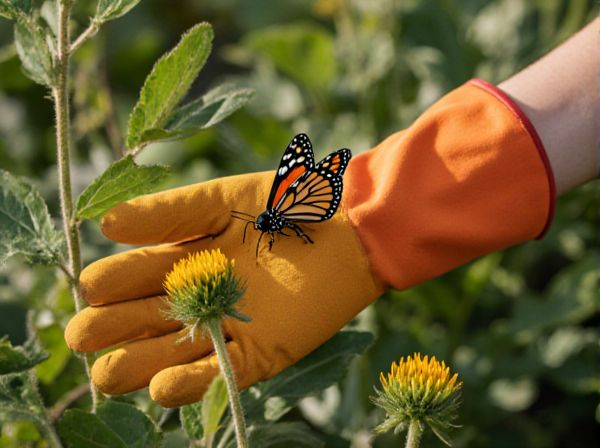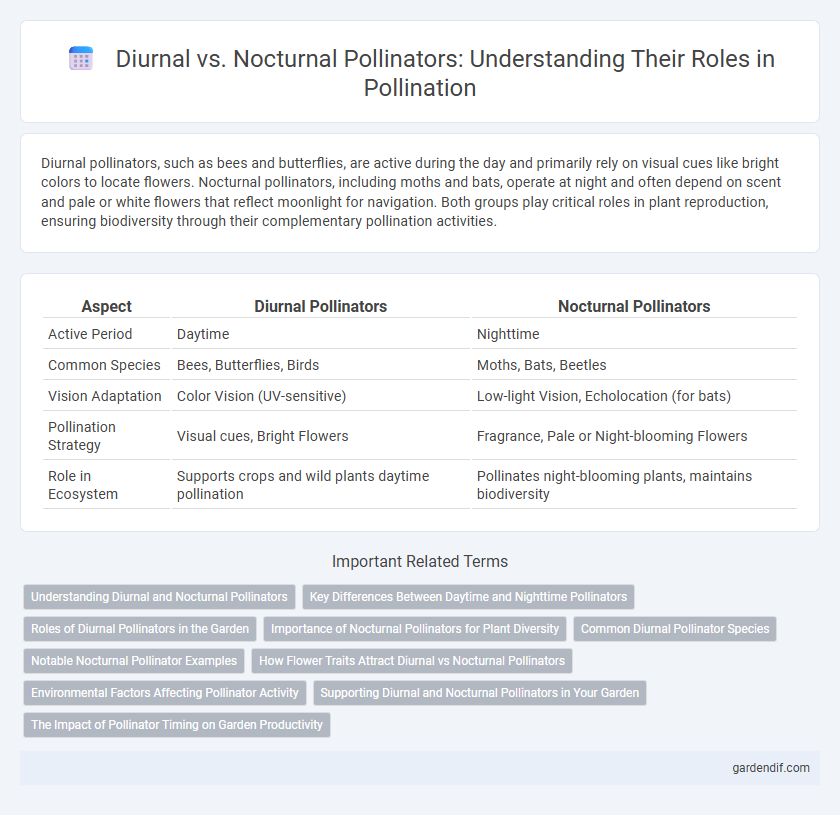
Diurnal pollinators vs nocturnal pollinators Illustration
Diurnal pollinators, such as bees and butterflies, are active during the day and primarily rely on visual cues like bright colors to locate flowers. Nocturnal pollinators, including moths and bats, operate at night and often depend on scent and pale or white flowers that reflect moonlight for navigation. Both groups play critical roles in plant reproduction, ensuring biodiversity through their complementary pollination activities.
Table of Comparison
| Aspect | Diurnal Pollinators | Nocturnal Pollinators |
|---|---|---|
| Active Period | Daytime | Nighttime |
| Common Species | Bees, Butterflies, Birds | Moths, Bats, Beetles |
| Vision Adaptation | Color Vision (UV-sensitive) | Low-light Vision, Echolocation (for bats) |
| Pollination Strategy | Visual cues, Bright Flowers | Fragrance, Pale or Night-blooming Flowers |
| Role in Ecosystem | Supports crops and wild plants daytime pollination | Pollinates night-blooming plants, maintains biodiversity |
Understanding Diurnal and Nocturnal Pollinators
Diurnal pollinators, such as bees and butterflies, are active during daylight hours and rely on visual cues like bright colors and floral patterns to locate nectar sources. Nocturnal pollinators, including moths and bats, operate at night, using olfactory signals and pale or white flowers for navigation in low-light conditions. Understanding the distinct behaviors and sensory adaptations of these pollinators is crucial for effective conservation and enhancing plant-pollinator interactions.
Key Differences Between Daytime and Nighttime Pollinators
Diurnal pollinators, such as bees and butterflies, are active during the day and rely heavily on visual cues like bright-colored flowers and ultraviolet patterns to locate nectar. Nocturnal pollinators, including moths and bats, navigate using olfactory signals and are drawn to pale or white flowers that emit strong scents at night. These contrasting adaptations highlight key differences in sensory preferences and flower characteristics between daytime and nighttime pollination strategies.
Roles of Diurnal Pollinators in the Garden
Diurnal pollinators, such as bees, butterflies, and hummingbirds, play a crucial role in gardens by actively transferring pollen during daylight hours, which enhances the fertilization of many flowering plants. These pollinators contribute to increased fruit and seed production by visiting a wide variety of garden flowers with bright colors and strong scents tailored to attract daytime activity. Their activity supports biodiversity and strengthens plant resilience, promoting healthier and more vibrant garden ecosystems.
Importance of Nocturnal Pollinators for Plant Diversity
Nocturnal pollinators, such as moths, bats, and certain beetles, play a crucial role in maintaining plant diversity by pollinating night-blooming flowers that diurnal pollinators often miss. These species facilitate cross-pollination in ecosystems where floral resources are only available after sunset, ensuring genetic diversity and the reproduction of key plant species. Their activity supports the survival of numerous plants with specialized adaptations, contributing significantly to biodiversity and ecosystem resilience.
Common Diurnal Pollinator Species
Common diurnal pollinator species include honeybees, butterflies, and hummingbirds, each playing a crucial role in the pollination of flowering plants during daylight hours. Honeybees (Apis mellifera) are highly efficient in pollinating crops like apples, almonds, and blueberries, while butterflies contribute to the pollination of wildflowers and garden plants. Hummingbirds actively forage on brightly colored, tubular flowers, facilitating pollination through their unique hovering feeding behavior.
Notable Nocturnal Pollinator Examples
Notable nocturnal pollinators include moths, bats, and certain species of beetles, which play crucial roles in ecosystems by pollinating night-blooming plants such as cacti, yucca, and saguaro. Moths, particularly hawk moths, have specialized long proboscises adapted for deep-tubed flowers, while fruit bats contribute to pollination in tropical and desert environments. These nocturnal species complement diurnal pollinators by ensuring plant reproductive success outside daylight hours, promoting biodiversity and ecosystem stability.
How Flower Traits Attract Diurnal vs Nocturnal Pollinators
Flower traits such as color, scent, and nectar production are adapted to attract either diurnal or nocturnal pollinators. Diurnal pollinators like bees and butterflies are drawn to bright, vivid colors and strong, sweet fragrances, while nocturnal pollinators such as moths and bats are attracted to pale or white flowers with stronger, muskier scents that are easier to detect in low light. Nectar accessibility and flower shape also differ, with diurnal flowers often featuring open, landing-friendly structures, whereas nocturnal flowers tend to have tubular shapes suited for specialized pollinator feeding.
Environmental Factors Affecting Pollinator Activity
Diurnal pollinators such as bees and butterflies are primarily influenced by sunlight intensity, temperature, and humidity, thriving in warm, bright conditions that enhance their foraging efficiency. Nocturnal pollinators like moths and bats depend on moonlight, temperature stability, and ambient humidity levels, which affect their navigation and flower visitation patterns. Environmental factors such as artificial light pollution and climate variations disrupt both diurnal and nocturnal pollination activities by altering natural cues essential for their behavior and survival.
Supporting Diurnal and Nocturnal Pollinators in Your Garden
Supporting diurnal pollinators such as bees, butterflies, and hoverflies requires planting a diverse array of brightly colored, nectar-rich flowers that bloom throughout the day. Nocturnal pollinators like moths and bats benefit from night-blooming plants with strong fragrances and pale or white petals that are easily visible in low light. Providing diverse habitats, including shaded areas, water sources, and undisturbed soil, maximizes the presence of both types and promotes effective pollination year-round.
The Impact of Pollinator Timing on Garden Productivity
Diurnal pollinators such as bees and butterflies are active during daylight hours, efficiently pollinating flowers that open in the morning and afternoon, which boosts garden productivity by aligning with peak photosynthesis periods. Nocturnal pollinators, including moths and bats, target night-blooming plants with unique floral traits like strong scents and pale colors, extending pollination to off-peak hours and enhancing fruit set in specific crops. Optimizing garden layouts with both diurnal and nocturnal pollinators ensures continuous pollination throughout the 24-hour cycle, maximizing yield and biodiversity.
Diurnal pollinators vs nocturnal pollinators Infographic

 gardendif.com
gardendif.com